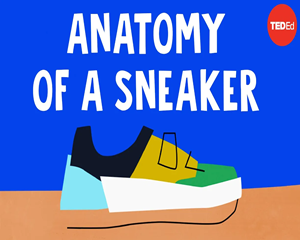Australians call them "runners." The British know them as "trainers." Americans refer to them as "tennis shoes” or "sneakers."
澳洲人叫它们“跑鞋 (runners)”,英国人叫它们“训练鞋 (trainers)”,美国人叫它们“网球鞋 (tennis shoes)” 或“球鞋 (sneakers)”。
Whatever you call them, these rubber-soled, casual shoes are worn by billions of people around the world.
无论你怎么称呼它,全世界有数十亿人穿着这些橡胶底的休闲鞋。
Originally invented in the late 19th century, these simple canvas and rubber creations have changed a lot since they first hit the pavement.
自19世纪后期被发明出来,这些原本简单的帆布和橡胶鞋从最开始推出至今已经改变了很多。
Today, sneaker consumption is at an all-time high. No country buys more sneakers than the United States, where people purchase 3 pairs a year on average.
如今,运动鞋的消费量达到了历史最高水平。没有其他国家像美国消费这么多运动鞋,美国人每人年均购买三双鞋。
To meet this demand, roughly 23 billion shoes are produced each year, mostly in factories across China and Southeast Asia.
为了满足这一需求,全球每年大约需要生产230亿只鞋,大多是由遍布中国和东南亚的工厂生产。
But making shoes has become more complicated, more labor-intensive, and in some ways, more dangerous, for the workers involved and for our planet.
但是制鞋已经成为更复杂、劳动强度更大,并且在某些方面也更危险的工作;不光对工人,对地球环境也有着负面影响。
Shoe manufacturing accounts for roughly one-fifth of the fashion industry's carbon emissions.
时尚产业的碳排放量,大约有五分之一来自制鞋业。
Sneakers alone generate 313 million metric tons of carbon dioxide every year, which is equivalent to the annual emissions of 66 million cars.
每年仅生产运动鞋就会产生3.13亿公吨的二氧化碳,相当于6600万辆汽车的年均排放量。
To better understand your shoe's carbon footprint, let's dive into the anatomy of a sneaker.
为了进一步了解你的鞋子所产生的碳足迹,让我们来了解一下运动鞋的内部结构。
For starters, the heel, insole, midsole, and upper layer are usually made from synthetic textiles like polyester, nylon, latex, and polyurethane.
首先,鞋跟、鞋垫、鞋底夹层和鞋面通常由合成纺织品制成,像聚酯、尼龙、乳胶和聚氨酯。
Mining the fossil fuels that make up these materials emits tons of greenhouse gases.
开采用来合成这类原料的化石燃料会排放大量的温室气体。
And processing those raw ingredients into synthetic textiles also uses a lot of energy, further compounding that pollution.
将这些燃料加工成合成纺织品也会消耗很多能量,进一步加剧了这种污染。
Some sneaker tops are made from natural sources like leather, but tanning this material relies on chromium; a carcinogenic chemical that can damage freshwater ecosystems.
有一些运动鞋的鞋面是由皮革等自然资源制成的,但是需要依靠铬为材料进一步上色,而铬是一种能够破坏淡水生态系统的致癌化学物质。
The outer soles of most shoes are made of rubber that's gone through a process called vulcanization.
大多数鞋子的外底由橡胶制成,这些橡胶度经过了“硫化”加工。
This technique adds sulfur to superheated raw rubber to create a material that's both elastic and sturdy.
该技术将硫添加到过热的生橡胶中以创造出有弹性且结实的材料。
Until recently, sneakers used natural rubber for this process.
很长时间以来,在这个过程中,运动鞋的制作都是使用天然橡胶。
But today, most outer soles are made with a synthetic blend of natural rubber and byproducts from coal and oil.
但是如今,大多数外底材料是由天然橡胶和煤及石油的副产品混合而成。

Producing these materials accounts for 20% of a sneaker's carbon footprint.
生产这些物料贡献了运动鞋碳足迹的20%。
But more than two-thirds of the shoe's carbon impact comes from the next step: manufacturing.
但整个生产过程超过三分之二的碳足迹实际上来自接下来的一步:制造。
A typical sneaker is comprised of 65 discrete parts, each of which is produced by specialized machinery.
标准的运动鞋由65个离散部件组成,每个都要通过专用机械流程产生。
This means it's cheaper for factories to mass-produce each piece separately rather than manufacturing every part under one roof.
这意味着,相比在同一个工厂中制造所有的部件,不同的工厂分别批量生产会降低各个工厂的成本。
But the transportation required to ship these pieces to one assembly plant emits even more CO2.
但是将这些部件运送到同一个装配厂的过程中,会有更多的二氧化碳被释放到空气中。
Once the components arrive at the assembly line, they undergo cutting, pouring, melting, baking, cooling, and gluing, before the final products can be stitched together.
各个部件到达装配厂后,它们将被切割、浇注、熔化、烘烤、冷却和上胶,最后,所有部件被缝制在一起。
The assembly of a typical sneaker requires more than 360 steps, and accounts for the remaining 20% of a sneaker's environmental impact.
标准运动鞋的组装过程需要至少360个步骤,而其剩余20%的环境影响就来自于此。
The dispersion of factories fuels another problem as well: labor abuse.
工厂分散导致的另一个问题是:劳工滥用。
Most brands don't own or operate their factories, so the plants they work with are in countries with little to no worker protection laws.
大多数品牌自身并不拥有或经营它们的工厂,所以跟他们合作的工厂都在一些几乎或完全没有工人保护法的国家。
As a result, many laborers earn below the living wage, and are exposed to harmful chemicals, like toxic glue fumes.
许多劳工的收入低于生活费用,而他们还会暴露在有害的化学物质中,如有毒的胶烟。
When manufacturing is complete, the shoes are packaged and transported to stores around the globe.
制造完成后,鞋子将被包装并运送到全球各地的商店。
For many, these shoes could last years. But for someone running 20 miles a week, a pair of running shoes will start wearing out after roughly 6 months.
对于许多人来说,这些鞋子可以穿好几年。但是对于那些一周跑20英里的人来说,一双运动鞋大概六个月后就会开始磨损。
Since the shoes are made of so many different materials, they're almost impossible to break down into recyclable components.
由于鞋子是由这么多不同的材料制成的,它们几乎不可能被分解,变成可回收的组件。
20% of these shoes are incinerated, while the rest are tossed into landfills where they can take up to 1,000 years to degrade.
20%的废弃鞋子将被焚化,而其余的则被丢进垃圾填埋场,在那里,它们可能需要花上一千年的时间才能分解。
So, how can we balance our love of sneakers with the need for sustainability?
那么,我们要怎样才能平衡我们对运动鞋的热爱和对可持续性的需求呢?
First, designers should streamline design elements and focus on eco-friendly materials.
首先,设计师们应该精简设计元素,并专注于使用环保材料。
Factories need to develop energy efficient manufacturing processes that consolidate steps and sneaker parts.
制鞋工厂要开发节能的制造过程,以合并制鞋步骤及各个部件。
And consumers should support companies using clean energy and ethical manufacturing processes.
消费者应支持采用清洁能源和人性化制造流程的企业。
We can also buy fewer shoes, wear them for longer, and donate those we no longer need.
我们也可以少买鞋,穿久一点,将那些不再穿的鞋捐出。
So no matter what your style, we can all take steps towards a sustainable future.
这样一来,无论你穿哪种风格的鞋,我们都能迈向一个可持续的未来。


